 German Empire (1896) Victoria Luise, Freya, Vineta, Herta, Hansa
German Empire (1896) Victoria Luise, Freya, Vineta, Herta, HansaWW1 German Cruisers
Irene class | SMS Gefion | SMS Hela | SMS Kaiserin Augusta | Victoria Louise class | Prinz Adalbert class | SMS Prinz Heinrich | SMS Fürst Bismarck | Roon class | Scharnhorst class | SMS BlücherBussard class | Gazelle class | Bremen class | Kolberg class | Königsberg class | Nautilus class | Magdeburg class | Dresden class | Graudenz class | Karlsruhe class | Pillau class | Wiesbaden class | Karlsruhe class | Brummer class | Königsberg ii class | Cöln class
The first Class of German Protected cruisers:
The second class of proper German “Kreuzer” appeared after SMS Kaiserin Augusta, later used as a training ship. These were more compact and more agile than the latter but heavier, rolling and rocking more while specs varied among shipyards.
Victoria Luise was the first laid down, on 1896 in Weser the others in Vulcan and Danzig, Herta, Freya, Vineta and Hansa, the last launched in 1898, accepted for service in 1898-99.
Names were those of Germanic godesses apart SM Victoria Luise (last daughter of Emperor Wilhelm II). They took part in the Boxer war, were stationed in the America, China and Mediterranean staitons, were modernized in the early 1900s but in 1916 they were all retired as training ship with skeleton crews and scrapped in 1918-1920. #kaiserlichesmarine #germannavy #imperialgermannavy #ww1 #1914-1918 #victorialuise #kreuzer #armouredcruisers
#kaiserlichesmarine #germannavy #imperialgermannavy #ww1 #1914-1918 #victorialuise #kreuzer #armouredcruisers
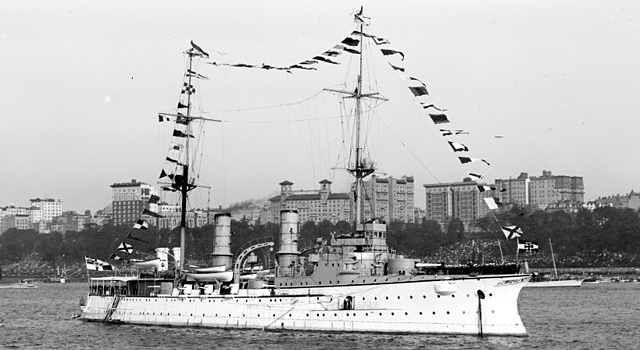
SMS Victoria Luise in the Hudson River before the war
Origins
The RMA (German Navy engineering department) started work on another proposal of cruiser by early 1894, Kaiser Wilhelm II entered into the discussions, submitting his own proposal: A 2nd-class cruiser clearly inspired by contemporary French cruisers, in June. The RMA noted that the new cruisers woud need to be at least as large as as the recent Gefion, and on the same budget. The Kaiser continued to submit his ideas, including two different 3rd-class cruisers. One, submitted in October, incorporated lessons from the First and very fresh Sino-Japanese War. The Battle of the Yellow River in particular, showed the superiority of protected cruisers with large quick-firing guns, over ironclads with slower-firing guns. Wilhelm thus wanted two 21 cm (8.3 in) quick-firing guns on the new ships, and this was written and confirmed by October.
RMA’s head, Hollmann, setup the final requirements for what was coded the “K” class in November. The 21 cm guns had to be fully enclosed inside armored gun turrets and there was to be a secondary battery of 15 cm (5.9 in) guns with other specifications left undecided. Discussions went on over the machinery; Retaining the standard two-shaft propulsion system or repeat the three-shaft arrangement of Kaiserin Augusta. Wilhelm approved last parameters while Chief Constructor, Alfred Dietrich, woorked on this and setup a way more detailed proposal, approved by the Kaiser by 31 December.
However the Reischstag did not approved the K class before the 1895–1896 budget year, and only three, with the latest RMA proposal of 6,000-ton cruisers, that were to be laid down in 1895. Two more were authorized for FY1896–1897. The Kaiser had its first class of five protected cruisers.
They were 60% lighter than Kaiserin Augusta, but with a much heavier armament and reflecting the arrangement of the Kaiser Friedrich III-class battleships, with similar fwd military mast, pole mainmast, gun turrets and casemates. Coming from different yards they would differ in size and had various water-tube boilers, notably for comparative evaluation, which became the norm in the Kaiserliches Marine. Their design was a landmark for protected cruiser as well as for the German cruiser lineage as they announced the future armored cruisers. A bit like French ships of that era they had some tumblehome, and were quite tall, with a very specific combined clipper bow and ram. This style prevailed up to the Scharnhost class in 1906. It should be noted that all these ships were classed as “Schwere Kreuzer” (heavy cruisers) making no distinction between “protected” and “armoured”.
Design of the Victoria Luise
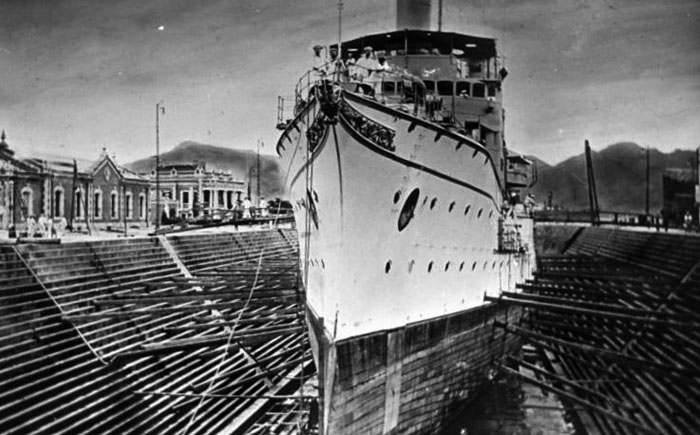
prow of SMS Hansa II in drydock – Bundesarchiv
The first three Victoria Luise class vessels, including Hertha and Freya measured “only” 109.10 meters (357 ft 11 in) at the waterline but 110.60 m (362 ft 10 in) overall at the tip of their prow. In beam they reached 17.40 m (57 ft 1 in) with a relatively limited draft of 6.58 m (21 ft 7 in) forward, 6.93 m (22 ft 9 in) aft. Displacement was 5,660 metric tons (5,570 long tons) as designed, or standard. This reached 6,491 t (6,388 long tons) fully loaded.
The next and last ships, SMS Vineta and Hansa were longer, measuring 109.80 m (360 ft 3 in) at the waterline but shorter overall at 110.50 m (362 ft 6 in). In beam they reached 17.60 m (57 ft 9 in) for a 7.08 m (23 ft 3 in) draft forward, 7.34 m (24 ft 1 in) aft. Displacement rose a bit to 5,885 t (5,792 long tons) standard, 6,705 t (6,599 long tons) fully loaded.
As for their construction, the hulls comprised longitudinal and transverse steel frames but they still had a a single layer of wood planking for possible colonial use, and had a layer of Muntz metal sheathing c1 m (3 ft 3 in) above the waterline as anti-fouling protection, later removed from the first three ships.
The ships’ standard crew was 31 officers and 446 enlisted men, with an additional 9 officers and 41 enlisted while serving as a second command flagship. After their reconstruction into training ships, the crew was substantially enlarged to incorporate the trainees, with 26 officers and 658 sailors, 75 of whom were naval cadets and 300 others were cabin boys. The ships carried a number of smaller boats, including three picket boats, one launch, one pinnace, two cutters, two yawls, and three dinghies. After their modernization, the boats were significantly revised; the number of picket boats was reduced to one, a barge and a launch were added, the dinghies were removed, and five more cutters were added.
The ships were good sea boats; they had an easy motion and were dry as a result of their high forecastles. They had a tendency to pitch when steaming downwind, however, and made severe leeway in heavy winds because of their large superstructures. They were difficult to maneuver without the center shaft engaged. Steering was controlled with a single rudder. They lost only around ten percent speed in a head sea or with the rudder hard over. In addition, as the lower coal bunkers were emptied, the ships became increasingly unstable; with empty bunkers, the ships could heel over as much as fifteen degrees in a hard turn. The modernization of the ships between 1905 and 1911 rectified this problem. They had a transverse metacentric height of .56 to .73 m (1 ft 10 in to 2 ft 5 in). As built, the ships were very hot, and ventilation had to be improved before they were commissioned.
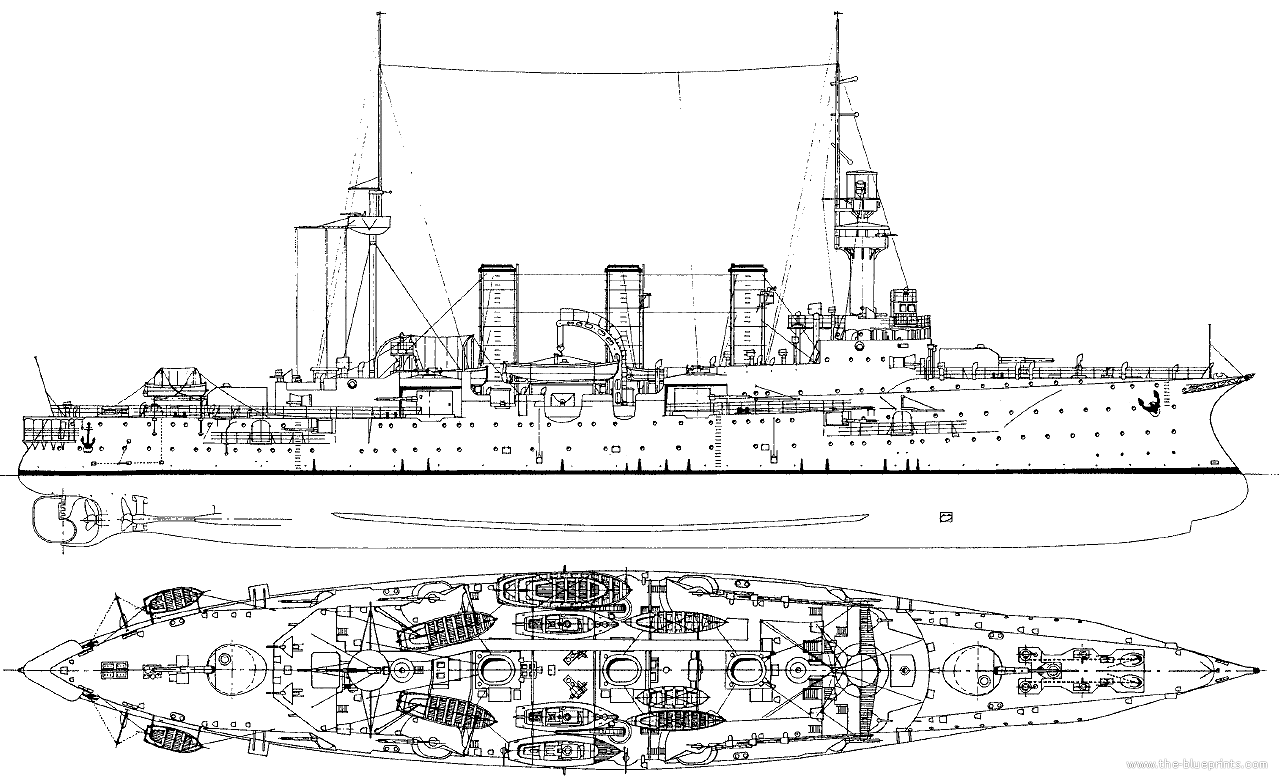
SMS Victoria Louise 1898 Protected Cruiser blueprint
Machinery
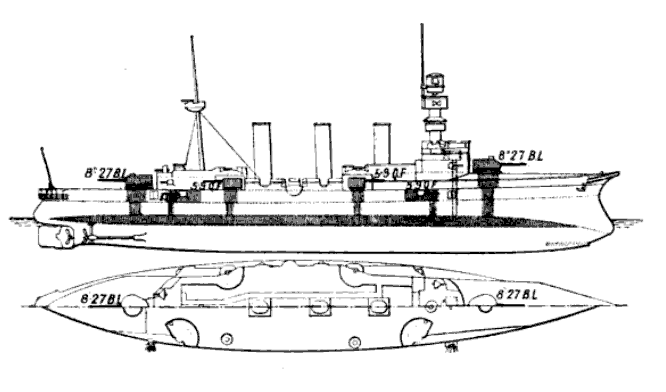
Victoria Luise – Ships drawing
The propulsion system was the same for all ships at leas for their vertical 4-cylinder triple-expansion steam engines (VTE), all from AG Vulcan. This consistancy helped to better compared the different boilers. Steam was indeed provided by twelve (eighteen for Hansa) coal-fired water-tube boilers. They came from Dürr AG for Victoria Louise and Vineta, Niclausse for Freya, Belleville for Hertha. Hansa’s eighteen transverse Belleville boilers were pretty unique among them. The Niclausse proved to be quite troublesome. The Dürr boilers were not very satisfactory either. The end of the sea trials convinced the navy to trust Schulz-Thornycroft for their future Marine-type boilers. These boilers were ducted into three funnels. However post-modernization (1905-1908) this came down to two funnels.
This powerplant generated a total of 10,000 metric horsepower (9,900 ihp), which was enough for an idea top speed of 19.5 knots (36.1 km/h; 22.4 mph) for the first three, but down to 18.5 knots (34.3 km/h; 21.3 mph) for the last two, heavier. They had enough internal space to load 950 t (930 long tons) of coal in normal conditions (twice as much if needed) for a range of 3,412 nautical miles (6,319 km; 3,926 mi) at the cruisind speed of 12 knots (22 km/h; 14 mph). After the 1905–1911 refit, better boilers provided a range of 3,840 nmi (7,110 km; 4,420 mi). Victoria Louise and Hertha were unique in having four electricity generators (224-271 kilowatts capacity or 300 to 363 hp/110 Volts for internal lighting and numerous system, whereas the last three had three generators for a total ouptut of 169-183 kW (227 to 245 hp) at the same voltage.
Armament
The armament was three-tiered and rounded by torpedo tubes.
Primary armament:
The two 21 cm SK L/40 C/97 were placed in single gun turrets forward and aft. They used a C/97 type mounts hydraulically operated, hand-loaded. They depressed and elevate to -5 and +30 degrees, which for the latter enabled a range of 16,300 m (53,500 ft). These guns had a 4-5 rounds per minute rate of fire. HE and AP shells had a muzzle velocity of 780 m/s (2,600 ft/s), with 58 rounds provided each, weighting 238 kg (525 lb) for the HE.
Evolutions of the same guns (C/01, 04) were fitted to the next armoured cruisers up to the Scharnhorst class.
Secondary armament:
All five ships had the same secondary battery, plcaed in various ways. The Eight 15 cm SK L/40 were for half, mounted in turrets amidships and the remaining four in casemates. They fired AP shells at at 4-5 per minute, depress to −7°, elevate to +20° giving them a 13,700 m (14,990 yd) range, close to the main guns. They weighed 51 kg (112 lb) with a muzzle velocity of 735 m/s (2,410 ft/s). Like the main guns they all elevated and trained manually. However after the refit two were removed (DP 8,8 cm guns were mounted instead).
Anti-Torpedo Boats armament:
Only to deal with Torpedo Boats, the ships were given ten 8.8 cm SK L/30 naval guns. They were spread between casemates and pivot mounts and a fired 7.04 kg (15.5 lb) shell at 590 mps (1,936 fps) MV. Rate of fire was greater at 15 shells per minute and at a range up to 6,890 m (7,530 yd). They were also manually operated. Thus battery was completed for even greater firepower (and much faster rate) by ten 3.7 cm (1.5 in) Maxim machine cannon and this was rounded by ten Maxim 037 mm MGs. All were later removed.
Torpedo armament:
The three 45 cm (18 in) torpedo tubes (eight torpedoes reloads) saw two launchers on the broadside, above the surface, the third in the bow as customary at the time. These torpedoes were of the 18-in type (450 mm), 5.1 m (201 in) long with a 87.5 kg (193 lb) TNT warhead. They had two settings: 26 knots (48 km/h; 30 mph) and 800 m (870 yd) or 32 knots (59 km/h; 37 mph) and 500 m (550 yd).
In 1916, these ships were all disarmed and so they kept their TTs.
Protection
Armor protection was made entirely of Krupp steel:
-Main deck 40 mm (1.6 in), sloped to 100 mm (3.9 in) thick slopes.
-Forward conning tower 150 mm (5.9 in) walls, 30 mm (1.2 in) roof.
-Aft conning tower splinter protection, 12 mm (0.47 in) walls.
-21 cm and 15 cm gun turrets: 100 mm thick sides, 30 mm roofs and crowns.
-Casemate guns 100 mm walls, 70 mm bulkheads.
As for ASW protection, the hulls were divided into 12 watertight compartments, later down to 11 except Freya. They also had cork cofferdams like in French ships. Their double bottom ran over 60% of their length.
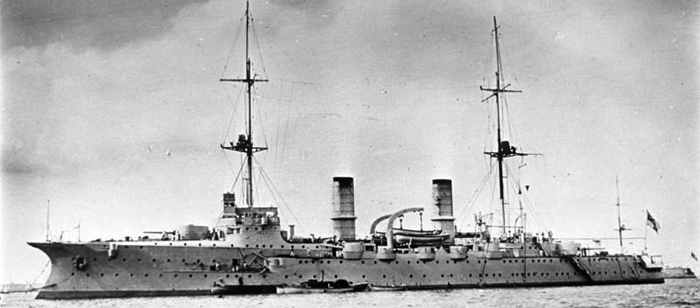
SMS Hansa II – Bundesarchiv
Modernization
The powerplant was considerably modified with brand new boilers, which greatly improved efficiency, but were still coal-burning. This ws done gradually, in 1906 for Victoria Louise and the next years in 1907 for Freya, in 1908 Hertha, in 1909 Hansa and in 1911 Vineta. These eight new Marine boilers were all identical and enabling to truncate exhaust lines into two funnels. Also to improve stability, the original military tower type foremast and fighting top were removed, replaced by a pole mast. Top speed did not changed but range was improved.
As for armament, two secondary 149mm/37 guns were removed as well as all ten 7.9mm/79 LMGs, for the addition of a single 88mm/27 SK L/30 C/89, and three 88mm/32 SK L/35 C/01.
In 1916 was partly disarmed, kept with a single 149mm/37 SK L/40 C/97, four 105mm/42 SK L/45 C/11, fourteen 88mm/27 SK L/30 C/89 and 88/32 SK L/35 C/01.
The eleventh L/30 was added with their modernization as well three longer-barreled 8.8 cm SK L/35 naval guns much improved the potency of their forepower at longer range. The 3.7 cm proved all but useless. In fact Freya was re-equipped as a gunnery training ship whereas the other ships were stricken and their crews freed for more modern light cruisers, such as the Köln class.
SMS Victoria Louise Illustration
⚙ specifications |
|
| Displacement | 5,660 to 5,885 t standard, 6,491 to 6,705 t FL |
| Dimensions | 110.50–110.60 x 17.40–17.60 x 6.58–7.08m (362 ft 6 in x 57 ft 1 in x 21 ft 7 in) |
| Propulsion | 3 shafts VTE, 12× fire-tube boilers 10,000 ihp (7,500 kW) |
| Speed | 18.5 to 19.5 knots (34 to 36 km/h; 21 to 22 mph) |
| Range | 3,412 nmi (6,319 km; 3,926 mi) at 12 knots (22 km/h; 14 mph) |
| Armament | 2× 21 cm, 8× 15 cm, 10× 8.8 cm, 3× 45 cm TTs |
| Protection | Deck 4 to 10 cm, Turrets 10 cm, Casemates 10 cm, CT 15 cm |
| Crew | 31 officers, 446 enlisted men |
Read More/Src
Books
Compton-Hall, Richard (2004). Submarines at War 1914–1918. Periscope Publishing.
Dodson, Aidan (2016). The Kaiser’s Battlefleet: German Capital Ships 1871–1918. Barnsley: Seaforth Publishing.
Gröner, Erich (1990). German Warships: 1815–1945. Vol. I: Major Surface Vessels. NIP
Hildebrand, Hans H.; Röhr, Albert & Steinmetz, Hans-Otto (1993). Die Deutschen Kriegsschiffe
Levine, Edward F. & Panetta, Roger (2009). Hudson–Fulton Celebration Of 1909. Charleston: Arcadia Pub.
Conway’s All the World’s Fighting Ships 1860–1905. Conway Maritime Press.
Van der Kiste, John (1999). Kaiser Wilhelm II: Germany’s Last Emperor. Stroud: Sutton.
Dodson, Aidan; Nottelmann, Dirk (2021). The Kaiser’s Cruisers 1871–1918. NIP
Nottelmann, Dirk (2023). Wright, Christopher C. (ed.). The Development of the German Armored Cruiser 1854–1918, Part IIIb
Links
The V.Luise class on wikipedia
Victoria Luise On deutsche-schutzgebiete.de
navypedia.org victoria_louise.htm
worldnavalships.com
historyofwar.org/
armament on navweaps.com
navweaps.com 21 cm guns
The Modeller’s corner:
Gallery
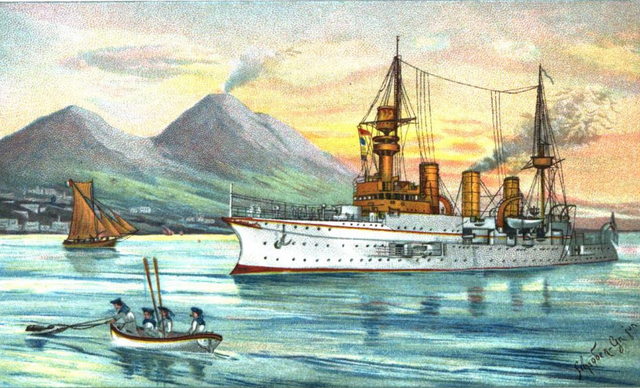
Freya, engraving, early service
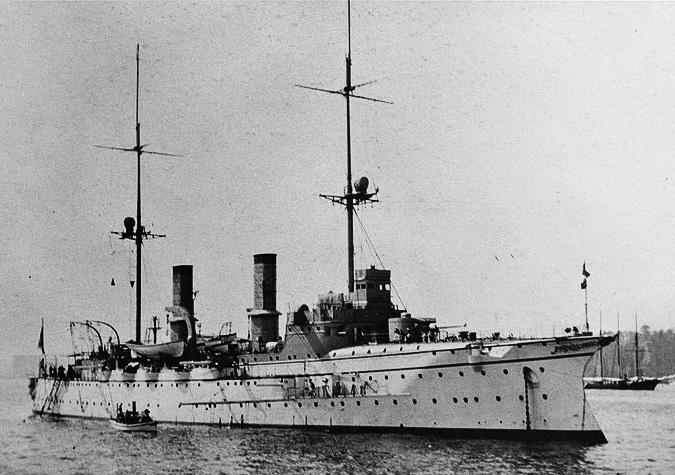
Hertha, later service after refit
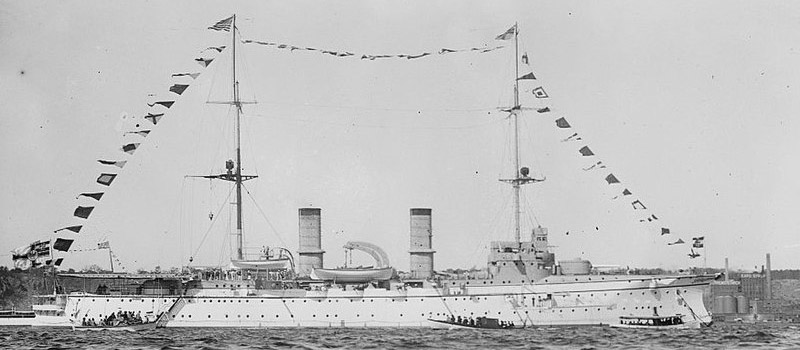
SMS Hertha, US coast commemorations
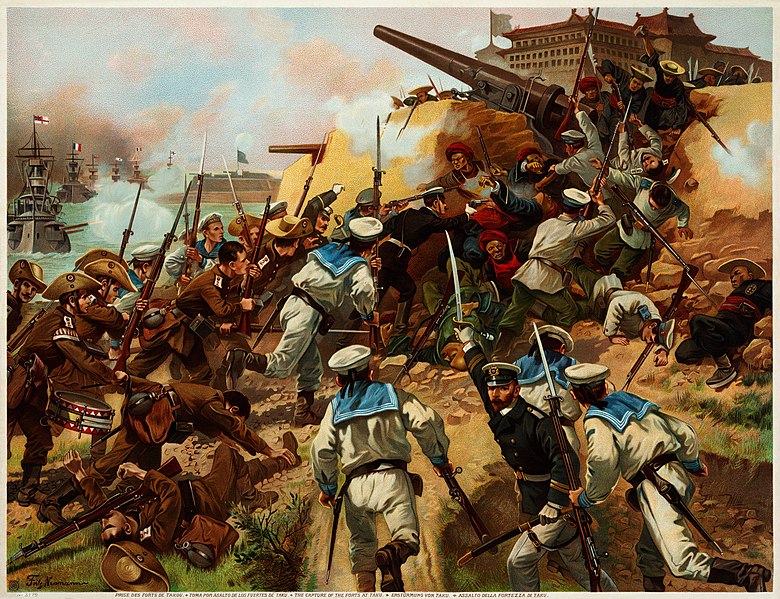
The capture of the Taku Forts, with Hertha’s crews, Boxer war
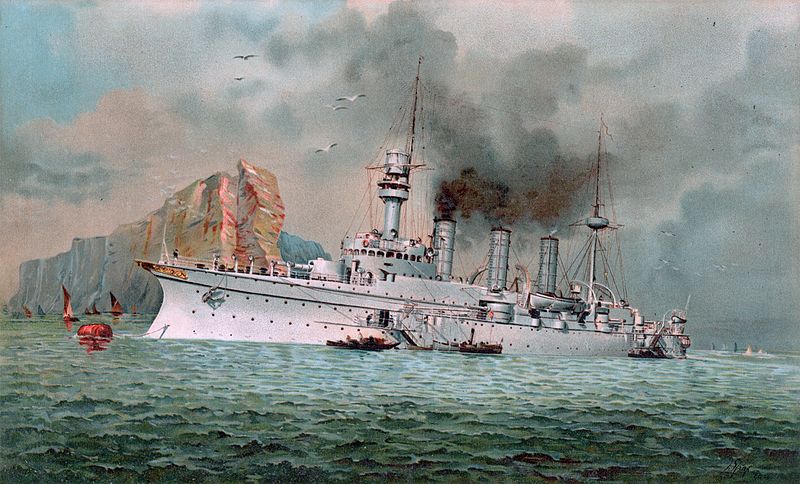
Hertha, date unknown, early service
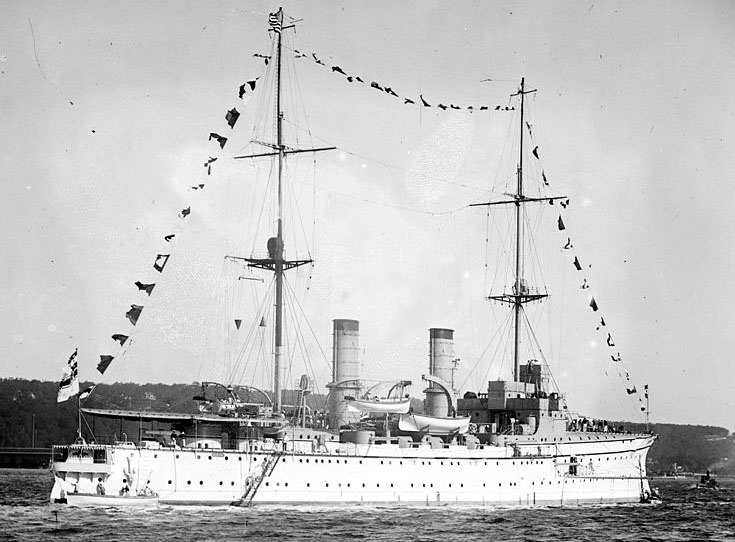
Hertha in the US, commemorations.
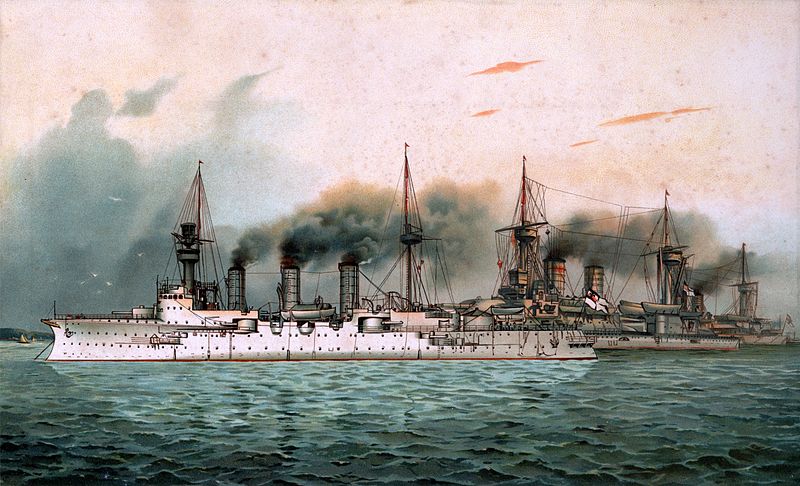
Victoria Luise and Friedrich Wilhelm in Weissenburg, early years un home waters
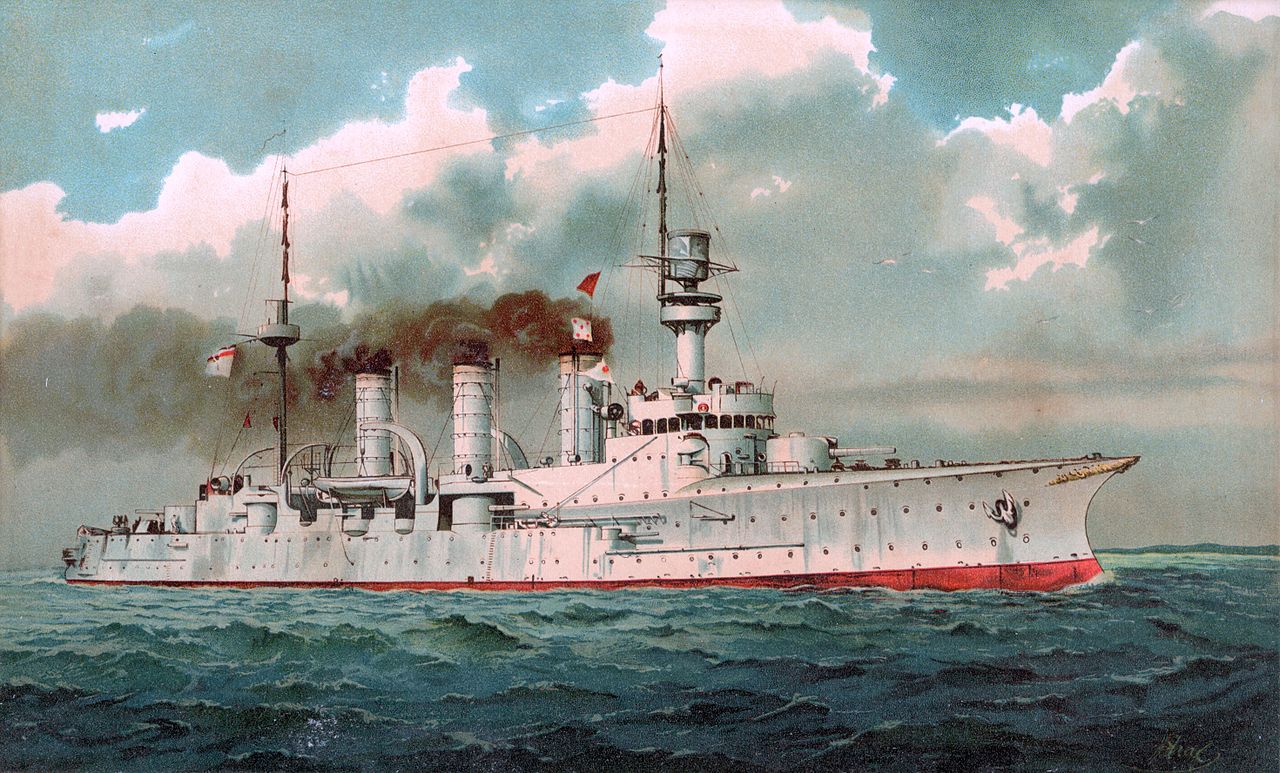
Lithogray of Hansa, early years

SMS Hansa after refit, date unknown
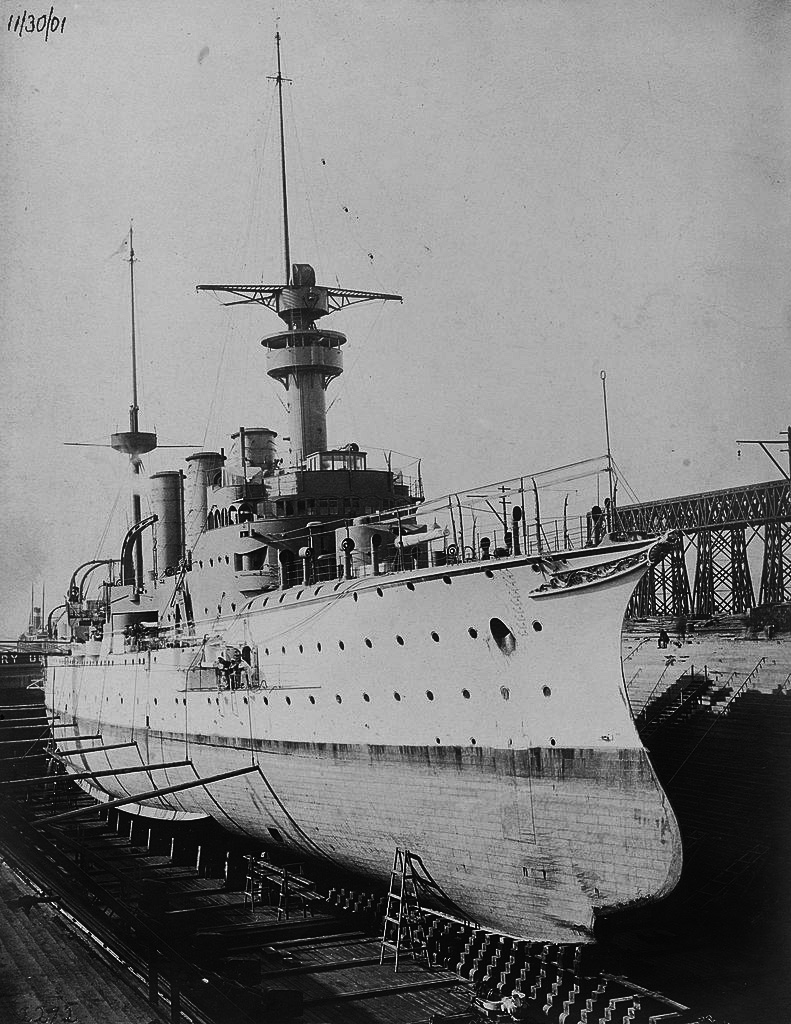
Vineta in drydock preior to refit. The very tall hull is obvious here.
Career
In 1914 these cruisers constituted the 5th lighting squadron, Freya becoming a training ship for the eastern squadron. By 1915, the four were reclassified as training ships in the same wing and disarmed in 1916 disarmed except Freya to free crews, the hull still used as utility ships. Victoria Luise was sold and attempted to be converted as a freighter 1920 but even after extensive transformation she proved a failure and was BU two years later. Remaining ships were BU in 1919-21.
 Victoria Louise (1897)
Victoria Louise (1897)
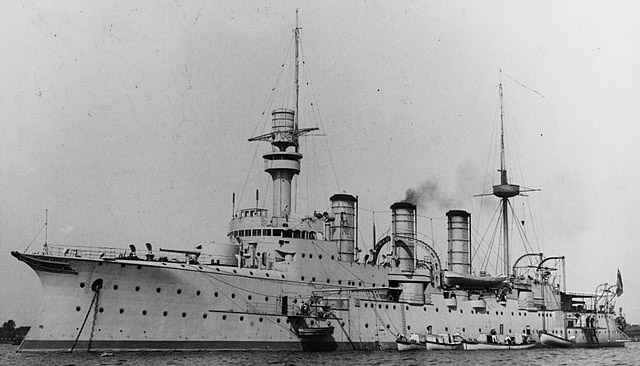
SMS Victoria Luise at Anchor, after completion
Victoria Louise was ordered under the contract name “L” and built at AG Weser, Bremen, on 9 April 1896. Launched on 29 March 1897 she was commissioned on 20 February 1899 under Kapitän zur See Hugo Westphal, made her sea trials but was soon temporarily decommissioned, reserve for improvements at Kaiserliche Werft. She made her final trials on 22 August 1900 under KzS Hans Meyer until 21 December, followed by more improvements. She only joined the squadron on 28 January 1901, under Prince Heinrich and sailed to Britain for the funeral of Queen Victoria, in 1901 until 7 February. Next she joined the I Battle Squadron on 20 April until 28 February 1903 taking part in annual training and briefly with the Artillerie-Inspektion (Artillery Inspectorate), in home waters apart another visit to Britain in early 1902.
The annual fleet maneuvers of the autumn 1902 saw her operating with Amazone and Hela, I Scouting Group, and under Konteradmiral Ludwig Borckenhagen (deputy commander of I Squadron as flagship) until 14 December 1902. From March 1903 she ws assigned to the I Scouting Group with SMS Prinz Heinrich. She cruised to Spain, and Vigo. On 26-30 October she assisted the coastal defense ship Hildebrand and became flagship, Vice Admiral Ernst Fritze (II Battle Squadron). Netx came manoeuvers on the Baltic and North Seas and she was decom. in Wilhelmshaven, and later drydocked in 1906 for modernization at Kaiserliche Werft, Kiel. In 1908 she started a new career as training ship for naval cadets, training command, based in Kiel, making short cruises in the Baltic-North Seas
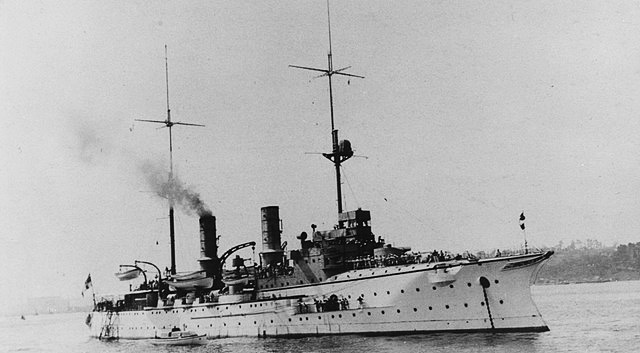
Victoria Louise After refit.
SMS Victoria Louise made an overseas cruiser by July 1908 with a scientific commission for atmospheric research with balloons. In Madeira (Portugal), Tenerife (Canary Islands) she made important tests and discoveries with a balloon reaching 21,800 m (71,500 ft). She made later a Mediterranean cruiser, Messina, where she joined Hertha to provide assistance after an earthquake. She was back to Kiel on 10 March. Her second cruise overseas started August 1909 via the Azores to the US, Newport News (12 September) joining Hertha, Bremen and Dresden in September under Admiral Mauve for the Hudson–Fulton Celebration until 9 October. She hosted Grand Admiral Hans von Koester as official representative. She trained in the West Indies and was back to Kiel on 10 March 1910.
She started next year’s cruise on 11 August to the Mediterranean, Corfu, and back to Kiel on 7 March 1911, had some maintenance. She was at Flensburg for the opening ceremonies of the Mürwik Naval School followed by a Baltic and Norwegian cruise, stopping at Balestrand to be visited by Wilhelm II. Next she sailed to Iceland, North America, and the West Indies, and back to Kiel on 4 March 1912. She visited Stockholm later in June.
The 1912 training cruise started on 10 August via Antwerp (visited by King Albert I), crossed the Atlantic for North America and West Indies, and protected nationals at Veracruz, back to Kiel on 10 March 1913. Her last training cruise started on 11 August, to the Mediterranean. In December she stopped at Piraeus visited by King Constantine I and his wife Sophia (Wilhelm II’s sister) for Christmas. Back to Kiel on 5 March 1914 she made another Baltic summer cruise when learning about the July Crisis.
World War I and fate
From 28 July 1914, she was remobilized as part of V Scouting Group, patrolling between Dornbusch and Møn in Denmark and on 17 October, she neary was torpedoes by submarine HMS E1 (Noel Laurence) which missed at 460 m (1,510 ft), too deep. Due to their weak armor protection the naval staff decided the whole class to be disbanded on 28 October. Victoria Luise went to Danzig, disarmed between 1 and 7 November, decommissioned.
Converted into a minelayer and barracks ship in Danzig she stayed in port until 1918. By order of 4 July 1919 she was stricken, sold to the Norddeutscher Tiefbau company, rebuilt as the cargo Flora Sommerfeld for the Danziger Hoch-und Tiefbau GmbH but scrapped in 1923, in Danzig.
 SMS Freya (1897)
SMS Freya (1897)
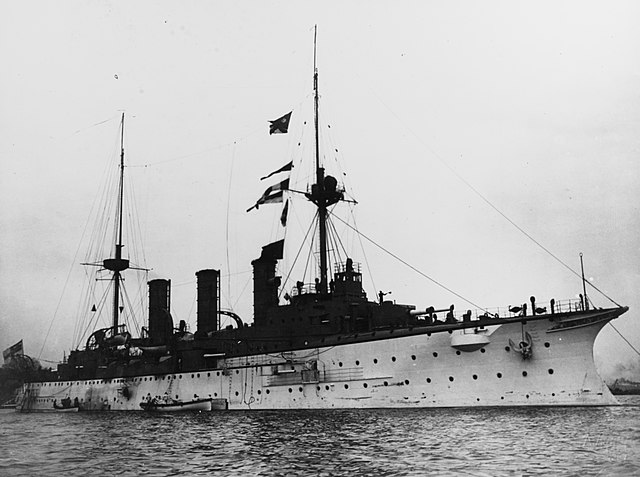
SMS Freya was ordered as “Ersatz Freya”, laid down at Kaiserliche Werft Danzig, on 2 January 1896, launched on 27 April 1897 and after sea trials and fixes to her boilers, she was commissioned on 20 October 1898, making more sea trials and assigned to II Division, I Battle Squadron, replacing the sold SMS Sachsen. By March 1899 she was lightly damaged in a collision with a ship built for the Ottoman Empire free for her moorings. KzS Hugo Westphal took command by October 1900 and trained the crew hard with the fleet up to mid-1901, but still making more trials until 8 June, decommissioned and tested with the Artillery Testing Command on 14 December 1901, recommissioned fully on 3 May 1902 under Hermann Jacobsen, fleet exercizes in Kiel. She joined the training fleet as scout for annual large-scale maneuvers in August-September but suffered damage to her boilers. After repairs she was back to gunnery training duties alongside her tender Brummer. They accidentally collided on 13 November (no damage). Same routine in 1903 and she was decommissioned on 11 January 1904 in Wilhelmshaven and converted by decision of the naval command as training ships for naval cadets, replacing old screw corvettes.
In 1905 she was drydocked at Kaiserliche Werft for modernization, re-boilered but keeping her three funnels, until early 1907, recommissioned on 4 April under KzS Franz von Holleben. She later made a western Baltic Sea cruise and was at the Kiel Week regatta.
From 19 July she went to Norway, Atlantic coast ports and Canary Islands, then Mediterranean, Venice, Beirut, Alexandria and back to Kiel on 18 March 1908. A routine of training cruise in the North Sea, Atlantic, North America followed and she was present by August in Halifax for the 150th anniversary of the opening of the Canadian Parliament. While there she rammed a schooner in heavy fog. She also trained in the Caribbean Sea and was back to Kiel on 8 March 1909.
Netx cruise started by 2 June 1909, to Norway, Cuxhaven, Wilhelmshaven and the Mediterranean, Funchal-Tenerife, then eastern Mediterranean, Alexandria assisting the city after a major fire and the Levant, back on 28 March 1910, followed by an overhaul until 2 May. From Kiel she made a training cruise to Norway and back.
On 1 August 1910 she made another long cruise, heading for Mexico with a special envoy aboard and cruised along the coast of South America, representing Germany at the 100th anniversary of Mexico’s independence. She was also in Veracruz on 3 September where her envoy met the President of Mexico. On 16 September she was at the inauguration of the Alexander von Humboldt’s monument, donated by the Kaiser. Freya trained in the Caribbean and was back in Kiel on 13 March 1911, Danzig, decommissioned on 28 March for a second modernization, her Niclausse boilers removed and modern Marine-type boilers installed, two funnels. She joined the reserve fleet, decommission in 1913.
From July 1914 she was reactivated as training ship, for boiler room personnel. With the new Training Inspectorate from April 1915 she returned to Baltic training from Flensburg until 1918. She was stricken on 25 January 1920, barracks ship for police in Hamburg, BU there in 1921.
 Vineta (1897)
Vineta (1897)
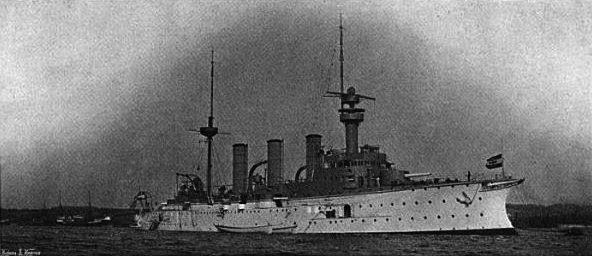
SMS Vineta was ordered as “M”, laid down at the Kaiserliche Werft Danzig by mid-1896, launched on 9 December 1897, commissioned 13 September 1899 under Kapitän zur See Hermann da Fonseca-Wollheim, for sea trials until 24 March 1900, fixes, and prepared in Kiel for her first cruise, by 26 May to South America. Indeed she was assigned the American Station.
Based in Saint Lucia, Lesser Antilles on 14 June (Carribean) she became the core of the new American Station (disbanded for years) replacing SMS Geier transferred in 1898. She trained off Venezuela and in the Caribbean, visited New Orleans, Mexico, Trinidad and sailed to the eastern coast of South America. She visited Margarita Island (Venezuela) to see its potential as naval base, en route but proceeded to La Plata and back to Venezuelan waters by 1 August, La Guaira. She stayed to protect German nationals and interests (Thousand Days’ War with Colombia). She was reinfocerced by the old Falke, Stein and Moltke in a show of force for reparations. On 6 October, two sailors from Vineta were arrested in Caracas so she launched a landing party in La Guaira to obtain their release. When a German merchant vessel was fired this was also resolved diplomatically. When it calmed down, Vineta sailed to Newport News for periodic maintenance until December.
When she returned, Gazelle (arrived in February 1902) becale her new companion. Vineta returned to Newport News for an overhaul until 25 September and afterwards visited Port-au-Prince (Haiti) after fire were exhanged between the German gunboat Panther and Haitian gunboat Crête-à-Pierrot, sunk (Markomannia incident). Falke replaced Vineta, returning to Venezuela.
Next Vineta took an important role in the Venezuelan crisis of 1902–1903, in high tensions between Venezuela and Britain, Germany, and Italy after Pdt. Cipriano Castro imposed a blockade of several coastal cities and provoked suspended payments of foreign debts. After policing for any German merchant vessels seized and agreement on 1 December between powers to end the blockade had a new cruiser division led by Vineta created, alongside Falke, Gazelle, and Panther, and training ships Stein and Charlotte, called the “East American Cruiser Division” under Kommodore Scheder, her captain.
On 7 December and ultimatum given was ignored and the German fleet started to seize or neutralize Venezuelan warships alonsgide HMS Retribution and HMS Quail under his command. Operations went on between 10 and 14 December, Gazelle capturing the gunboat Restaurador, Vineta assisting the German consul in La Guaira with landing parties ashore. The 13th saw the British merchant ship SS Topaze boarded, crew arrested and HMS Charybdis bombarded forts at Puerto Cabello, enlisted Vineta in the attack. They destroyed the fortresses Libertador and Vigia and freed Topaze and her crew. Castro later ordered the release of all British and German nationals arrested but still refused to give into Germano-British demands, so they started a complete blockade of the Venezuelan coast on 20 December, joined by Italy. For this, Vineta, Falke, Gazelle, Panther, Charlotte, Stosch, and Restaurador patrolled, supplued by the HAPAG steamer SS Sibiria. They were joined by Vice Admiral Archibald Douglas aboard the protected cruiser Ariadne, relieving Scheder as commander of the international squadron. On 4 January 1903 a German landing party occupied Puerto Cabello, seize all ships in the harbor. By 17 January, Panther attacked Fort San Carlos (Maracaibo). She was soo assisted by Vineta. She fired 20x 21 cm and 86x 15 cm shells to ruin the fortress. The United States due to the Monroe Doctrine intervened after attack on Fort San Carlos. A settlement resulted in an agreement about debt payments and the blockade ceased.
The East American Cruiser Division later roured the West Indies, Haiti. A 15 cm ammunition magazines exploding (no casulaties) had the German concerned about powder storage, an a new composition was mainstream by 1914, a stable propellant which saved many shuips during WWI. Vineta sailed to Halifax for another overhaul and she was on Saint Thomas by October, later cruising the West Indies in December 1903 and January 1904, stopping at New Orleans with the division, then Veracruz in February. While in New Oerlans by July she was visited by President Theodore Roosevelt.
She later toured the eastern coast of South America, Brazil, notably Rio de Janeiro, then was order to cross the Atlantic to German South West Africa to deal with the Herero rebellion, supported by the Portuguese colony of Angola. Oddly the Russian Second Pacific Squadron just stopped to coal here at Lüderitz Bay en route to Tsushima. Vineta assisted the steamer SS Gertrud Woermann uloading colonial troops and supplies on 19–20 November. She was shadowed by British cruiser HMS Barrosa, Portuguese gunboat Cacongo there. She sailed off Duala (Kamerun) in January 1905 and ordered home, Wilhelmshaven on 14 March (the East American Cruiser Division was disbanded).
Assigned to the Torpedo Inspectorate on 30 March in Kiel, she was modernized at Kaiserliche Werft, converted as torpedo test ship. She became flagship of the Torpedo Testing Command under KK Eberhard von Mantey, Schäfer and Friedrich Schultz. In 1907 she tested wireless telegraphy and cruised to Vigo in May, then annual maneuvers until 7 September in the reconnaissance screen. She was dry-docked until 5 September 1908, replaced by SMS Friedrich Carl, decommissioned in Danzig.
Converted as training ship for naval cadets and apprentices she ws refitted in Kaiserliche Werft, re-boilered and restarted service by 29 March 1911 under KzS Karl Sievers. She cruised to Norway anf the West Indies and in 1912, visited Stockholm, and Libau, and went on to the Mediterranean from 6 August, western with SMS Hertha and Geier. She was sent to Constantinople on 15 November when the Mediterranean Division was created. She moved to Crete after the Bulgarian war ceasefire resumed by February 1913. Based in Alexandria on 2 January she was back in Kiel on 5 March.
On 11 August 1913 she started her last overseas cruise to South America, West Indies, protect nationals in Haiti by January 1914, meeting there the dreadnought USS South Carolina and USS Montana, sending all landing parties. Pdt. Michel Oreste abdicated and fled with his family aboard Vineta, transferred to the steamer SS Prinz Eitel Friedrich to Colombia for exile. Vineta was home by 16 March, toured Swedish ports until the summer of 1914.
She was in maintenance at Kaiserliche Werft and assigned the V Scouting Group, western Baltic for patrol, sailed to Bornholm and later Lyserort in Russia. In November she was withdrawn to Kiel, a barracks ship for U-boat crews until Nov. 1918, stricken on 6 December 1919, sold and scrapped 1920.
 Hertha (1897)
Hertha (1897)
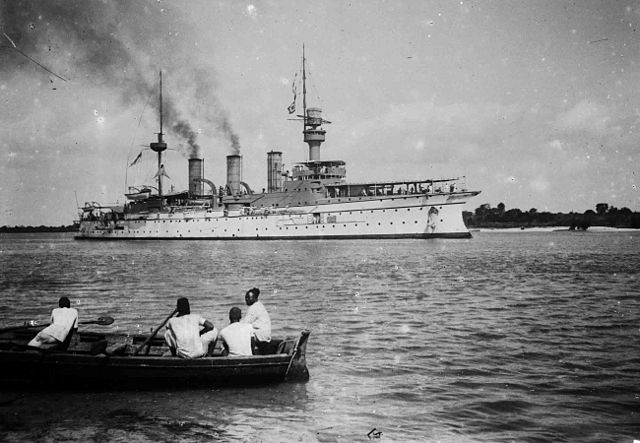
SMS Hertha at Dar-Es-Salaam
SMS Hertha was ordered as “K”, laid down at AG Vulcan, Stettin in October 1895, launched on 14 April 1897, completed at Kaiserliche Werft (lightly rammed by Baden here), commissioned on 23 July 1898 for sea trials under Korvettenkapitän Guido von Usedom. Her trials saw measures of mile tests filmed with Oskar Messter’s black-and-white “kinetoscope”, a first. She had issues with her boilers, but accompanied the aviso Hela escorting Kaiser Wilhelm II’yacht Hohenzollern to the Mediterranean. She stopped in Gibraltar, Venice, Constantinople, Jaffa, Haifa, Beirut, Port Said. She relieved SMS Oldenburg in the International Squadron after the Cretan Revolt. She had boilers fixes in Genoa by November and struck by a merchant vessel free fors moorings by a strong gale. Gio. Ansaldo & C. shipyard completed repairs and she was ordered to the East Asia Squadron after trials, setting sail on 11 April 1899 via Singapore and arriving in Qingdao, Jiaozhou Bay (Leased Territory) on 8 June, relieving the old ironclad Kaiser, under KAdm—Rear Admiral Ernst Fritze, making her his flagship. Cruises went to Amoy to meet Hansa (new flagship) and Hong Kong with SMS Deutschland. She was dry docked here for maintenance and hosted later Vizeadmiral Felix von Bendemann on 17 February 1900.
Ater a tour of Japan (visited by Emperor Meiji) with Hertha, Hansa, Kaiserin Augusta, Irene, Gefion she was in Qingdao on 23 April for squadron exercises before the squadron was dispersed for cruises in the region, Hertha going to the Yangtze, Hankou by mid-May and back to Qingdao. The Boxer Uprising cancelled a visit and had her prepared for war, and she was later placed under multinational command of British Vice Admiral Edward Seymour. The whole squadron less Irene met British ships at their Station off Taku, Hai River. They sent a landing party of 100 men in Tianjin. After sending a relief force to Tianjin and Beijing’s besieged legation, it was decided the combind squadron would deliver a party of 20 officers, 2 doctors and 487 sailors to the Expedition (1/4 of the international force) under command of Hertha’s XO Kfz Hecht. The expedition failed but the fleet was soon redeployed to bombard and send a new party to seize the reinforced Taku Forts. Herthas send 60 men, 4 officers led by KL Adolf von Trotha. Seymour’s force was back in Tianjin on 23 June and by 18 July this was over.
Another expedition by the Eight Nation Alliance started by mid-August (Hertha+Hansa sent 350 men, which made it to Beijing on 18 August. When Fürst Bismarck arrived on 17 August, Bendemann transferred his flag on her from Hertha, and new reinforcement from Germany, bolsting landing parties on 15 September undr Generalfeldmarschall Alfred von Waldersee. Hertha took part in the occupation of Shanhaiguan forts and remained later in Qingdao and Yantai. She suffed 7 men killed for her landing parties.
On 8 June 1908 she visited Kobe including a meeting with Meiji, next Nagasaki, and back to Qingdao. She made another cruise to Japan and 21 October, replaced Fürst Bismarck drydocked in Hong Kong (VAdm Richard Geissler). A new exchange proceeded while in Singapore. Hertha sailed to Uraga, drydocked until 5 May. From Nagasaki she sailed back to Qingdao, and made another Japan cruise. While off Formosa on 9 August she weathered a typhoon (significant flooding). Next she visited the Philippines, Dutch East Indies, Singapore. By early 1903 she was overhauled in Nagasaki and back to Qingdao, visiting Vladivostock and Korea, Japan. In 1904 she visited the Yangtze with Fürst Bismarck, Hankou, and back to Singapore. She needed a greaterr overhaul and was sent to Germany via the Seychelles and Dar es Salaam, Mediterranean, meeting Wilhelm II aboard Hohenzollern, sailing together on 8 April, the Kiel, decommissioned on 12 May.
In 1906 she was refitted and modernized at Kaiserliche Werft (boilers, armament) until early 1908, recommissioned under KzS Hugo Louran on 7 April as trainig ship for naval cadets and apprentices. By June she carried Prince Ludwig to Bornholm and Swinemünde. She started her first cruise from Bremerhaven to Norway, Scotland, and Ireland and Mediterranean via Funchal, Madeira, and Las Palmas, Palma de Mallorca, Alexandria, and toured Italy. In Corfu she met SMS Victoria Louise and they sailed to Messina for humanitarian assistance (earthquake). She was later visited by Queen Elena of Italy on 5 January and King Vittorio Emanuele III. Both was back in Corfu and proceeded to Germany, Kiel, on 15 March.
On 5 June she stated a new cruiser and by August represented Germany at the Hudson–Fulton Celebration with Victoria Louise by September-October. She cruised in the Caribbean Sea, visited Kingston, Jamaica, assisted HAPAG SS Prinz Joachim von Preussen running aground. She proceed to Kiel on 8 March. After another short training cruise to Norway-Baltic Sea in 1910, she was back in the Mediterranean on 15 August and Kiel on 7 March 1911. After another cruise in the Baltic (Sweden, Norway, Scotland) she went to the West Indies, then mid-Atlantic, Azores and Madeira, assisting SS Lotte Menzel in a mutiny. Hertha stopp edin Barcelona and joined the newly created Mediterranean Division on 2 November (flagship SMS Goeben) present for the Balkan Wars. She was back in Kiel on 7 March 1912.
After maintenance and cruise with naval cadets she made another trip to North America and the Caribbean, detached to Veracruz (Mexican Revolution) until 2 November, and back to Kiel on 13 March 1914. Her final cruise started on 2 June, central Baltic, Norway, North Sea (Edinburgh 22 to 25 July), last German ship to visit a British port.
Back by late July she was assigned to V Scouting Group, patrolling the western Baltic and later with Vineta and Friedrich Carl, made a sweep in the eastern Baltic 24-26 October under KAdm Gisberth Jasper (Hertha was his flagship); They proceeded to the Gulf of Finland but reports of enemy submarines had them withdrawn. She was later removed from service, stationed in Swinemünde, decom. on 16 November, converted a barracks ship in Flensburg, and seaplane base until 1918. Stricken on 6 December 1919, sold to Audorf-Rendsburg, scrapped in 1920.
 Hansa (1898)
Hansa (1898)
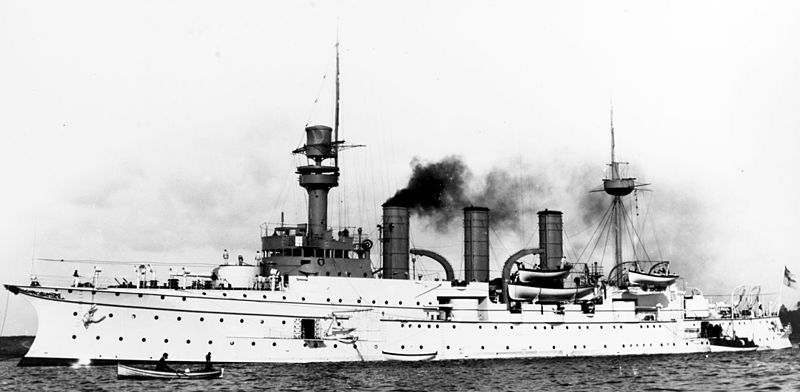
Hansa as completed
Hansa was ordered as “N”, laid down at AG Vulcan, Stettin in April 1896, launched on 12 March 1898, completed in Kiel in early 1899, commissioned on 20 April, started sea trials under KzS Emil Freiherr von Lyncker. On 6 June, she accidentally ran aground in the Great Belt (heavy fog), pulled free by the Odin and Ägir, later repaired. She completed her acceptance trials on 11 August and was soon assigned to the East Asia Squadron, sailing on 16 August but was plagued by engines and boilers troubles on the way, repaired en route. She stayed in the Levant from 31 August to 4 September to deliver gifts from Kaiser Wilhelm II to Jerusalem and Haifa. She crossed the Suez Canal, Red Sea, Indian Ocean, Maldives (hydrographic survey), Colombo for rest, only to see her engines and electric generators fails and new repairs carried out. She arrived in Singapore on 13 October but later en roite to station, suffered a boiler explosion (two killed) forcing her back to repairs in Singapore. She arrived at Amoy, China, on 26 October, meeting Hertha and Deutschland later. Deutschland was flagship for VaDM Prince Heinrich of Prussia, replaced by Hansa with Konteradmiral Ernst Fritze aboard. She sailed to Shanghai, and Hong Kong for a major engine overhaul. She mater was flagship for VAdm Felix von Bendemann (17 February) and went to Singapore, and back to Qingdao. Later KAdm Hermann Kirchhoff replaced Bendemann.
Her next cruise was stopped by the Boxer Uprising, and she joined the International fleet off the Taku Forts, taking part in the Battle of the Taku Forts, assisted by Hertha, Gefion, Irene, all landing Seebataillone (marines). Later she contributed 123 men led by XO Paul Schlieper to the Seymour Expedition. The cruiser proceeded to shell objectives at Beidaihe, Qinhuangdao, and Shanhaiguan but saw no more action until the end. When she recuperated her party, she had lost 13, pus 24 wounded.
Hansa started cruises to Japan which became a yearly occurence, and refits in Hong Kong. She was sent to Tsingtao on 5 March 1901 and represented the country in Australia for the Federation of Australia commemoration. She sailed via Singapore and Batavia to Fremantle, joined by SMS Cormoran, and proceeded to Sydney on 18 May before returning to Tsingtao via New Britain and Manila.
She later sailed the Yangtze to Nanking ( funeral ceremony for the viceroy of Guangxi Province) and again in March 1903, then Japan in April (visit by Emperor Meiji) and a fleet review in Kobe In July she was at the British naval base at Weihaiwei with Hai Chi. By late October her new captain was Henning von Holtzendorff. She went to Uraga and was overhaul until January 1904. She sailed later to and followed the start of the Russo-Japanese War, evacuating German nationals from Seoul, Port Arthur and Dalian.
By early March she stopped in Hong Kong, was joined by flagship Fürst Bismarck, seeing the arrival of the badly damaged Tsesarevich and three destroyers at Tsingtao after the Battle of the Yellow Sea. The crews and ships were interned. By May 1906, she assisted the Norddeutscher Lloyd steamer SS Roon (run aground Philippine Sea). She was ordered on 4 July to return to Germany, Danzig, decommissioned at Kaiserliche Werft, drydock for her major mid-life refit until April 1909. Like her sisters she became training ship for naval cadets and entered a routine alternating yearly summer Baltic cruises and overseas cruises the rest of the year. She went several times in the Mediterranean, HP in Kiel. She also cruised to the Caribbean and the East US Coast. Interesting note, from 1911 to 1912, Günther Lütjens served aboard Hansa, as commander of the naval cadets.
She made her final overseas cruise on 11 August in the Mediterranean, back home on 17 March 1914 and from July 1914 she became flagship of KAdm Gisberth Jasper, V Scouting Group, with sisters Victoria Louise, Vineta, and Hertha. They made a sweep in the central Baltic but were not assigned to the High Seas Fleet, but the new Baltic Sea Naval Forces (Prinz Heinrich). They made another sweep into the eastern Baltic, Gotland. After an overhaul in Danzig Hanqa went to Swinemünde, and then Kiel, decommissioned, a barracks ship for torpedo boat crews at the Kaiserliche Werft and stricken on 6 December 1919, sold for BU to Audorf-Rendsburg, 1920.
First published on October, 9, 2018.


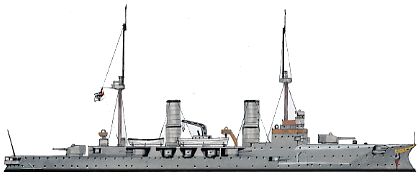
 Latest Facebook Entry -
Latest Facebook Entry -  X(Tweeter) Naval Encyclopedia's deck archive
X(Tweeter) Naval Encyclopedia's deck archive Instagram (@navalencyc)
Instagram (@navalencyc)





 French Navy
French Navy Royal Navy
Royal Navy Russian Navy
Russian Navy Armada Espanola
Armada Espanola Austrian Navy
Austrian Navy K.u.K. Kriegsmarine
K.u.K. Kriegsmarine Dansk Marine
Dansk Marine Nautiko Hellenon
Nautiko Hellenon Koninklije Marine 1870
Koninklije Marine 1870 Marinha do Brasil
Marinha do Brasil Osmanlı Donanması
Osmanlı Donanması Marina Do Peru
Marina Do Peru Marinha do Portugal
Marinha do Portugal Regia Marina 1870
Regia Marina 1870 Nihhon Kaigun 1870
Nihhon Kaigun 1870 Preußische Marine 1870
Preußische Marine 1870 Russkiy Flot 1870
Russkiy Flot 1870 Svenska marinen
Svenska marinen Søværnet
Søværnet Union Navy
Union Navy Confederate Navy
Confederate Navy Armada de Argentina
Armada de Argentina Imperial Chinese Navy
Imperial Chinese Navy Marinha do Portugal
Marinha do Portugal Mexico
Mexico Kaiserliche Marine
Kaiserliche Marine 1898 US Navy
1898 US Navy Sovietskiy Flot
Sovietskiy Flot Royal Canadian Navy
Royal Canadian Navy Royal Australian Navy
Royal Australian Navy RNZN Fleet
RNZN Fleet Chinese Navy 1937
Chinese Navy 1937 Kriegsmarine
Kriegsmarine Chilean Navy
Chilean Navy Danish Navy
Danish Navy Finnish Navy
Finnish Navy Hellenic Navy
Hellenic Navy Polish Navy
Polish Navy Romanian Navy
Romanian Navy Turkish Navy
Turkish Navy Royal Yugoslav Navy
Royal Yugoslav Navy Royal Thai Navy
Royal Thai Navy Minor Navies
Minor Navies Albania
Albania Austria
Austria Belgium
Belgium Columbia
Columbia Costa Rica
Costa Rica Cuba
Cuba Czechoslovakia
Czechoslovakia Dominican Republic
Dominican Republic Haiti
Haiti Hungary
Hungary Honduras
Honduras Estonia
Estonia Iceland
Iceland Eire
Eire Equador
Equador Iran
Iran Iraq
Iraq Latvia
Latvia Liberia
Liberia Lithuania
Lithuania Mandchukuo
Mandchukuo Morocco
Morocco Nicaragua
Nicaragua Persia
Persia San Salvador
San Salvador Sarawak
Sarawak Uruguay
Uruguay Venezuela
Venezuela Zanzibar
Zanzibar Warsaw Pact Navies
Warsaw Pact Navies Bulgaria
Bulgaria Hungary
Hungary

 Bundesmarine
Bundesmarine Dutch Navy
Dutch Navy Hellenic Navy
Hellenic Navy Marina Militare
Marina Militare Yugoslav Navy
Yugoslav Navy Chinese Navy
Chinese Navy Indian Navy
Indian Navy Indonesian Navy
Indonesian Navy JMSDF
JMSDF North Korean Navy
North Korean Navy Pakistani Navy
Pakistani Navy Philippines Navy
Philippines Navy ROKN
ROKN Rep. of Singapore Navy
Rep. of Singapore Navy Taiwanese Navy
Taiwanese Navy IDF Navy
IDF Navy Saudi Navy
Saudi Navy Royal New Zealand Navy
Royal New Zealand Navy Egyptian Navy
Egyptian Navy South African Navy
South African Navy






























 Ukrainian Navy
Ukrainian Navy dbodesign
dbodesign